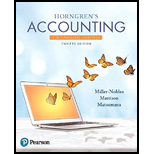
Horngren's Accounting, The Financial Chapters (12th Edition)
12th Edition
ISBN: 9780134486789
Author: Tracie L. Miller-Nobles, Brenda L. Mattison, Ella Mae Matsumura
Publisher: PEARSON
expand_more
expand_more
format_list_bulleted
Concept explainers
Question
Chapter 26, Problem E26.19E
To determine
The Payback period of capital budgeting is based on the concepts of the computation of period in each the investment made in the project will be going to realize back from the project. It helps in determining the length of the period which is required by the projects to recover the amount of investment made. Lower the payback period, better will be project and is preferred over other projects.
The Concepts underlying the payback period method of capital budgeting and computation of payback period for projects need to be determined.
Expert Solution & Answer
Want to see the full answer?
Check out a sample textbook solution
Students have asked these similar questions
Can you explain the correct approach to solve this general accounting question?
Please provide the answer to this general accounting question using the right approach.
Accounting solution
Chapter 26 Solutions
Horngren's Accounting, The Financial Chapters (12th Edition)
Ch. 26 - Prob. 1QCCh. 26 - Prob. 2QCCh. 26 - Prob. 3QCCh. 26 - Prob. 4QCCh. 26 - Prob. 5QCCh. 26 - Prob. 6QCCh. 26 - Prob. 7QCCh. 26 - The IRR is Learning Objective 4 the interest rate...Ch. 26 - Prob. 9QCCh. 26 - Ian Corp, is considering two expansion projects....
Ch. 26 - Prob. 1RQCh. 26 - Describe the capital budgeting process.Ch. 26 - Prob. 3RQCh. 26 - Prob. 4RQCh. 26 - Prob. 5RQCh. 26 - Prob. 6RQCh. 26 - What is the payback method of analyzing capital...Ch. 26 - Prob. 8RQCh. 26 - Prob. 9RQCh. 26 - What is the decision rule for payback?Ch. 26 - Prob. 11RQCh. 26 - What is the accounting rate of return?Ch. 26 - How is ARR calculated?Ch. 26 - Prob. 14RQCh. 26 - Prob. 15RQCh. 26 - What is an annuity? How does it differ from a lump...Ch. 26 - Prob. 17RQCh. 26 - Prob. 18RQCh. 26 - Prob. 19RQCh. 26 - Prob. 20RQCh. 26 - Prob. 21RQCh. 26 - Prob. 22RQCh. 26 - Prob. 23RQCh. 26 - Prob. 24RQCh. 26 - Prob. 25RQCh. 26 - Prob. 26RQCh. 26 - Prob. 27RQCh. 26 - Prob. 28RQCh. 26 - Prob. 29RQCh. 26 - Prob. 30RQCh. 26 - Prob. S26.1SECh. 26 - Prob. S26.2SECh. 26 - Prob. S26.3SECh. 26 - Prob. S26.4SECh. 26 - Prob. S26.5SECh. 26 - Prob. S26.6SECh. 26 - Prob. S26.7SECh. 26 - Using the payback and ARR methods to make capital...Ch. 26 - Prob. S26.9SECh. 26 - Prob. S26.10SECh. 26 - Prob. S26.11SECh. 26 - Prob. S26.12SECh. 26 - Prob. S26.13SECh. 26 - Prob. S26.14SECh. 26 - Prob. S26.15SECh. 26 - Prob. E26.16ECh. 26 - Prob. E26.17ECh. 26 - Prob. E26.18ECh. 26 - Prob. E26.19ECh. 26 - Prob. E26.20ECh. 26 - Using ARE to make capital investment decisions...Ch. 26 - Prob. E26.22ECh. 26 - Prob. E26.23ECh. 26 - Prob. E26.24ECh. 26 - Prob. E26.25ECh. 26 - Prob. E26.26ECh. 26 - Prob. E26.27ECh. 26 - Prob. E26.28ECh. 26 - Prob. P26.29APGACh. 26 - Prob. P26.30APGACh. 26 - Using payback, APR, NPV, IPP, and profitability...Ch. 26 - Using payback, ARP, and NPV with unequal cash...Ch. 26 - Prob. P26.33APGACh. 26 - Prob. P26.34BPGBCh. 26 - Prob. P26.35BPGBCh. 26 - Using payback, APR, NPV, IRR, and profitability...Ch. 26 - Prob. P26.37BPGBCh. 26 - Prob. P26.38BPGBCh. 26 - Using Excel for capital budgeting calculations...Ch. 26 - Prob. P26.40CPCh. 26 - Prob. 1CPCh. 26 - Prob. 2CPCh. 26 - Prob. 3CPCh. 26 - Prob. 4CPCh. 26 - Prob. 26.1TIATCCh. 26 - Prob. 26.1EICh. 26 - Prob. 26.1FC
Knowledge Booster
Learn more about
Need a deep-dive on the concept behind this application? Look no further. Learn more about this topic, accounting and related others by exploring similar questions and additional content below.Similar questions
- On January 1, 2022, Hoda Corp. sells a piece of equipment for $31,000. The equipment was originally purchased on January 1, 2020, for $56,000. The equipment was estimated to have a useful life of 4 years and a residual value of $0. Hoda uses straight-line depreciation. How will Hoda record this transaction?arrow_forwardWhat is the firm's total liabilities?arrow_forwardPlease provide the answer to this financial accounting question using the right approach.arrow_forward
arrow_back_ios
SEE MORE QUESTIONS
arrow_forward_ios
Recommended textbooks for you

 AccountingAccountingISBN:9781337272094Author:WARREN, Carl S., Reeve, James M., Duchac, Jonathan E.Publisher:Cengage Learning,
AccountingAccountingISBN:9781337272094Author:WARREN, Carl S., Reeve, James M., Duchac, Jonathan E.Publisher:Cengage Learning, Accounting Information SystemsAccountingISBN:9781337619202Author:Hall, James A.Publisher:Cengage Learning,
Accounting Information SystemsAccountingISBN:9781337619202Author:Hall, James A.Publisher:Cengage Learning, Horngren's Cost Accounting: A Managerial Emphasis...AccountingISBN:9780134475585Author:Srikant M. Datar, Madhav V. RajanPublisher:PEARSON
Horngren's Cost Accounting: A Managerial Emphasis...AccountingISBN:9780134475585Author:Srikant M. Datar, Madhav V. RajanPublisher:PEARSON Intermediate AccountingAccountingISBN:9781259722660Author:J. David Spiceland, Mark W. Nelson, Wayne M ThomasPublisher:McGraw-Hill Education
Intermediate AccountingAccountingISBN:9781259722660Author:J. David Spiceland, Mark W. Nelson, Wayne M ThomasPublisher:McGraw-Hill Education Financial and Managerial AccountingAccountingISBN:9781259726705Author:John J Wild, Ken W. Shaw, Barbara Chiappetta Fundamental Accounting PrinciplesPublisher:McGraw-Hill Education
Financial and Managerial AccountingAccountingISBN:9781259726705Author:John J Wild, Ken W. Shaw, Barbara Chiappetta Fundamental Accounting PrinciplesPublisher:McGraw-Hill Education


Accounting
Accounting
ISBN:9781337272094
Author:WARREN, Carl S., Reeve, James M., Duchac, Jonathan E.
Publisher:Cengage Learning,

Accounting Information Systems
Accounting
ISBN:9781337619202
Author:Hall, James A.
Publisher:Cengage Learning,

Horngren's Cost Accounting: A Managerial Emphasis...
Accounting
ISBN:9780134475585
Author:Srikant M. Datar, Madhav V. Rajan
Publisher:PEARSON

Intermediate Accounting
Accounting
ISBN:9781259722660
Author:J. David Spiceland, Mark W. Nelson, Wayne M Thomas
Publisher:McGraw-Hill Education

Financial and Managerial Accounting
Accounting
ISBN:9781259726705
Author:John J Wild, Ken W. Shaw, Barbara Chiappetta Fundamental Accounting Principles
Publisher:McGraw-Hill Education
Capital Budgeting Introduction & Calculations Step-by-Step -PV, FV, NPV, IRR, Payback, Simple R of R; Author: Accounting Step by Step;https://www.youtube.com/watch?v=hyBw-NnAkHY;License: Standard Youtube License